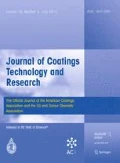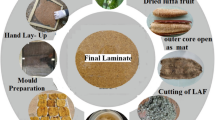Abstract
The purpose of this study was to investigate the performance of a semitransparent PVDF–acrylic coating on two wood species: Black spruce and White pine. An accelerated aging test was performed on the PVDF–acrylic coating and the results obtained were compared with those obtained for a water-based acrylic coating. Color changes were found to be more significant for the acrylic coating, especially after 1000 h of exposure, and for the White pine panels. Infrared spectroscopy revealed that the acrylic resin was more affected by the accelerated aging test than the PVDF resin, although X-ray photoelectron spectroscopy revealed that PVDF was slightly affected at the extreme surface (first 10 nm). Star-shaped defects were found at the surface of the White pine panels finished with the PVDF–acrylic coating. Experiments revealed that the PVDF–acrylic coating does not seem to be flexible enough to sustain resin exudation or other stresses.










Similar content being viewed by others
References
Feist, WC, Weathering and Protection of Wood. Forest Products Laboratory, 1983
Schaller, C, Rogez, D, “New Approaches in Wood Coatings Stabilization.” J. Coat. Technol. Res., 4 (4) 401–407 (2007)
Chiantore, O, Trossareli, L, Lazarri, M, “Photooxidative Degradation of Acrylic and Methacrylic Polymers.” Polymer, 41 1657–1658 (2000)
Custodio, JEP, Eusebio, MI, “Waterborne Acrylic Varnishes Durability on Woodsurfaces for Exterior Exposure.” Progr. Org. Coat., 56 59–67 (2006)
Allen, NS, Parker, MJ, Regan, CJ, McIntyre, RB, Dunk, WAE, “The Durability of Water-Borne Acrylic Coatings.” Polym. Degrad. Stab., 47 117–127 (1995)
Wood, KA, Cypcar, C, Hedhli, L, “Predicting the Exterior Durability of New Fluoropolymer Coatings.” J. Fluor. Chem., 104 63–71 (2000)
McKeen, Fluorinated Coatings and Finishes Handbook. William Andrew Publishing, Norwich, 2006
Gu, X, Michaels, C, Nguyen, D, Jean, Y, Martin, J, Nguyen, T, “Surface and Interfacial Properties of PVDF/Acrylic Copolymer Blends Before and After UV Exposure.” Appl. Surf. Sci., 252 (14) 5168–5181 (2006)
Sung, L, Vicini, S, Ho, D, Hedhli, L, Olmstead, C, Wood, K, “Effect of Microstructure of Fluorinated Acrylic Coatings on UV Degradation Testing.” Polymer, 45 6639–6646 (2004)
Hon, DNS, Shiraishi, N, Wood and Cellulosic Chemistry, 914 p. CRC Press, Boca Raton, 2000
Okudaire, KK, Yamane, H, Ito, K, “Photodegradation of Poly(tetrafluoroethylene) and Poly(vinylidene fluoride) Thin Films by Inner Shell Excitation.” Surf. Rev. Lett., 9 335–340 (2002)
Acknowledgments
The authors want to thank Isabelle Gélinas and Renaud Gilbert from Société Laurentide for their help, as well as Tommy Martel for the experimental work.
Author information
Authors and Affiliations
Corresponding author
Rights and permissions
About this article
Cite this article
Landry, V., Blanchet, P., Zotig, L. et al. Performance of exterior semitransparent PVDF–acrylic coatings. J Coat Technol Res 10, 37–46 (2013). https://doi.org/10.1007/s11998-012-9421-y
Published:
Issue Date:
DOI: https://doi.org/10.1007/s11998-012-9421-y




